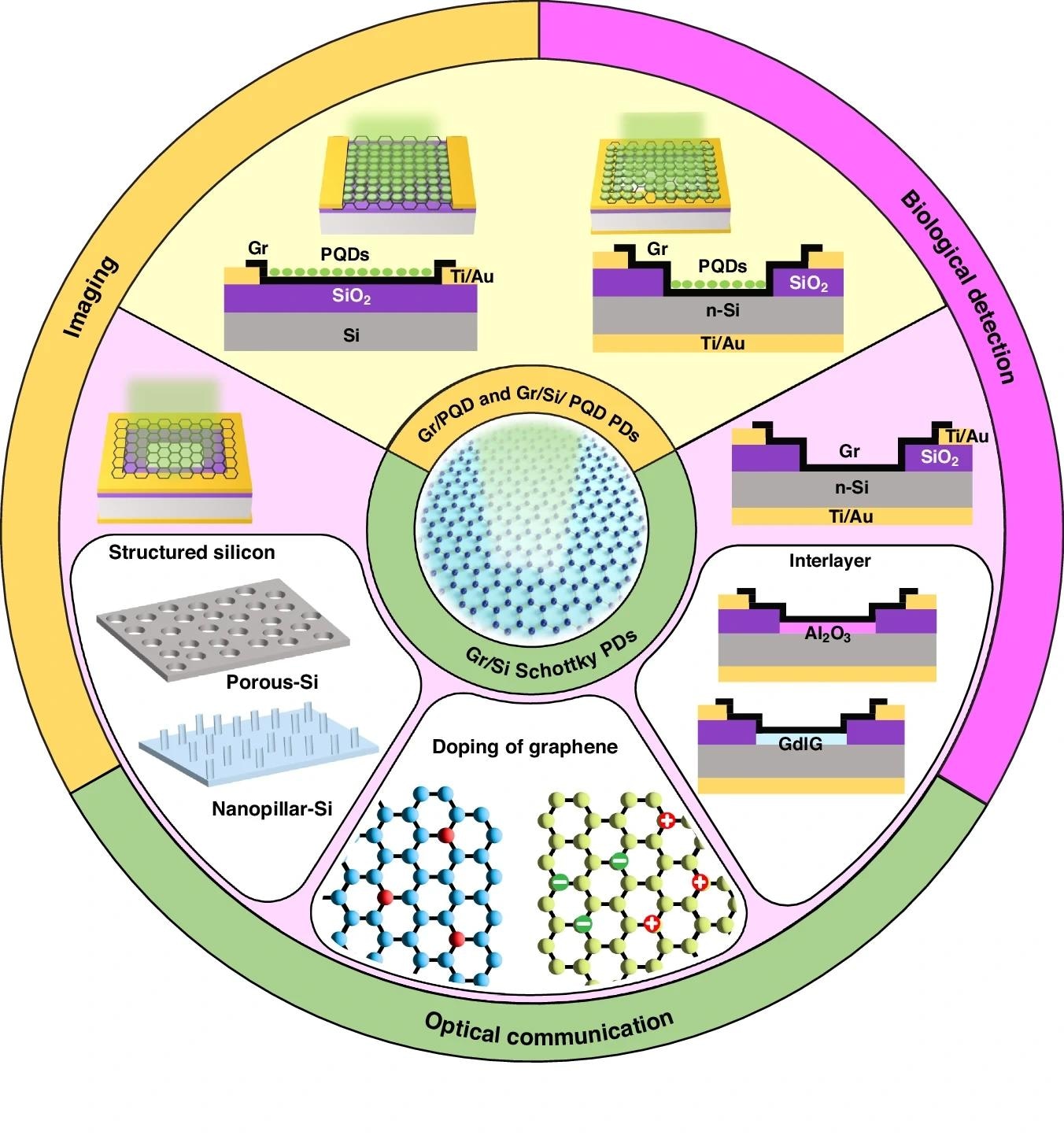In an article recently published in the journal Microsystems & Nanoengineering, researchers reviewed the integration of graphene photodetectors with perovskite quantum dots (PQDs) and silicon (Si).
 Schematic illustration of Gr/Si Schottky PDs, Gr/PQD PDs, and Gr/Si/PQD hybrid PDs, as well as their optimization methods and applications. Image Credit: https://www.nature.com/articles/s41378-024-00722-4
Schematic illustration of Gr/Si Schottky PDs, Gr/PQD PDs, and Gr/Si/PQD hybrid PDs, as well as their optimization methods and applications. Image Credit: https://www.nature.com/articles/s41378-024-00722-4
Limitations of Graphene Photodetectors
Photodetectors play a critical role in many sectors, including biomedical imaging, industrial production, and optical communications. These optoelectronic devices convert optical signals into electrical signals.
In recent years, graphene, a prominent two-dimensional (2D) material, has displayed significant photodetection potential. Graphene possesses ultrafast carrier dynamics, a broad absorption spectrum, and a tunable bandgap, which makes it suitable for optoelectronics.
However, the weak interaction of graphene with light poses challenges for real-world applications. Specifically, pristine graphene's light absorbance is only 2.3 % in the near-infrared and visible bands, which substantially limits the photoresponsivity of graphene-based photodetectors.
By embedding graphene into nanophotonic structures or integrating it with other photosensitive materials, the light-matter interactions can be enhanced. Among these methods, the integration with PQDs and Si has recently gained significant attention as it opened new avenues for graphene in the domain of next-generation optoelectronics.
Graphene/Si Schottky Photodetector
The simple graphene membrane transfer process onto three-dimensional (3D) silicon (Si) enables the formation of a graphene/Si heterostructure at a shallow depth. In this graphene/Si hybrid structure, carrier generation is stimulated by incident light, with most carriers generated in the Si, while graphene serves as a medium for carrier collection and transfer.
This approach leverages graphene's fast carrier dynamics and Si's high absorbance to revolutionize micro/nanoelectronic devices. Graphene/Si Schottky junctions have demonstrated high photodetection efficiency in recent years. For instance, studies have revealed that a graphene/Si Schottky photodetector can operate in both photocurrent and photovoltage modes, showing a spectral response from the ultraviolet to near-infrared regimes with a high photoresponse.
These detectors can exhibit adjustable responsivity when the Fermi level is modulated through bias voltage. Although Si's carrier mobility limits the detector's response speed, it still achieves millisecond-scale response times. However, the performance of graphene/Si Schottky photodetectors primarily depends on the Schottky barrier height, interface cleanness, and built-in electric field. Despite achieving broadband photodetection with high performance, the large dark current limits the specific detectivity of these detectors.
Additionally, the responsivity is limited to hundreds of mA/W due to the absence of a photocurrent gain mechanism. These challenges can be addressed through interface engineering, structuring planar Si, and doping graphene. Doping modulates the band structure and carrier density of graphene-based photodetectors, significantly improving their photoresponse properties.
The photodetection performance can also be enhanced using nanostructured Si in a graphene/Si Schottky junction for high optical gain and high light absorbance. Charge carrier dynamics and band alignment can be manipulated, and interface properties optimized, by incorporating interlayers into graphene/Si Schottky photodetectors to improve photodetection performance.
Graphene/PQD Hybrid Photodetector
PQDs are coated over a graphene film to create a graphene/PQD hybrid architecture. In this setup, PQDs act as light absorbers while graphene facilitates carrier transport, forming a current flow. The PQDs enhance and modulate the built-in electric field at the junction interface through proper band alignment, enabling efficient separation of photogenerated carriers.
Several studies have demonstrated the feasibility of combining PQDs and graphene to produce high-performance photodetectors. PQDs enhance charge carrier generation and light absorption due to their efficient charge transfer properties, high absorption coefficient, and tunable bandgap.
The unique qualities of PQDs and the flexibility of device construction through solution processing enable the fabrication of complex optoelectronic devices. PQDs can also be integrated into a graphene/Si Schottky junction to form a new hybrid architecture, combining the benefits of fast carrier separation in the graphene/Si Schottky junction with the long carrier lifetime and tunable absorption of PQDs.
When integrated into the graphene/Si junction, PQDs absorb incident photons across a broad spectral range. The generated electron-hole pairs are then transferred to the graphene layer due to its high conductivity. This mechanism enhances photodetection capabilities, resulting in improved sensitivity and detectivity in the graphene/Si/PQD photodetector.
Despite notable performance improvements in these hybrid graphene/Si/PQD photodetectors, fabricating such structures is challenging. Incompatibility of materials at the QD, Si, and graphene interface can lead to inhomogeneities and defects, degrading photodetector performance. Additionally, hybrid structures may exhibit varying material properties, leading to reliability issues over time.
In summary, graphene/Si Schottky junction and graphene/PQD hybrid photodetectors show high responsivity and detectivity across a broad spectrum, holding significant potential for flexible electronics. However, further research is needed to address challenges such as long-term stability.
Journal Reference
Abbas, K. et al (2024). Graphene photodetectors integrated with silicon and perovskite quantum dots. Microsystems & Nanoengineering, 10(1), 1-13. https://doi.org/10.1038/s41378-024-00722-4, https://www.nature.com/articles/s41378-024-00722-4
Disclaimer: The views expressed here are those of the author expressed in their private capacity and do not necessarily represent the views of AZoM.com Limited T/A AZoNetwork the owner and operator of this website. This disclaimer forms part of the Terms and conditions of use of this website.